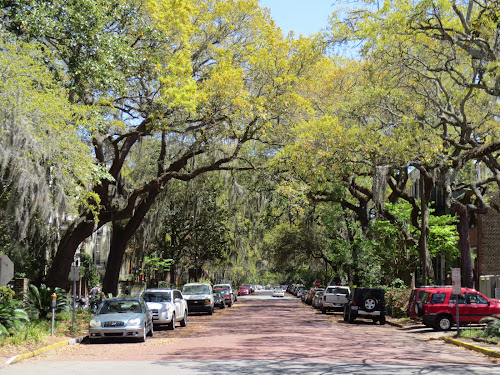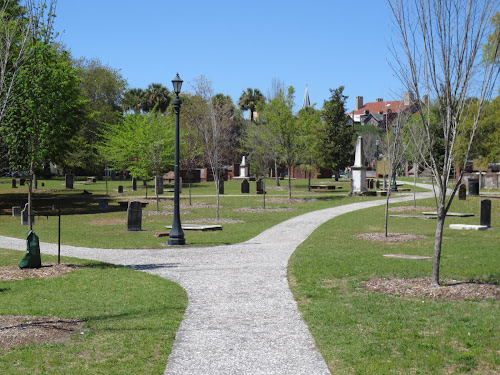Today we have our first truly warm day since arriving in America - upper 20's degrees C. Perfect except ...we don't have shorts yet - so we are in our light hiking pants and shirts as we join a 10am Savannah Architecture walking tour. We had researched walking tours on line and this one is led by a young qualified architect with a passion for Savannah.
We meet Jonathan, our guide, at Chippewa Square and get a brief run down of the history and early development of Savannah. Jonathan is very knowledgable and well organised, with laminated pictures to help tell the story.
For those interested, the history is that in 1733 an Englishman called Oglethorpe was commissioned by King George (we think II) to establish a colony as a buffer between the Spanish residing in Florida and the already developed city of Charleston in South Carolina. Oglethorpe was a military man so he laid the city out around square training grounds, now 24 public squares, and very clear straight roads and rules on development of homes and uses blocks of lands. He also established 4 "bans":
- No slavery (how quickly things changed!)
- No alcohol (again, this did not last long)
- No Catholics, as they might sympathize with the Spanish, and
- No lawyers!
Architecturally, Savannah has every possible style, which is fascinating to compare and contrast. Below are 1800's row houses with exposed local brick. Originally it would have been stuccoed to protect the porous Savannah bricks but many have been stripped back to brick over time and as a result the buildings or at leadt the brickworks are crumbling.
Our tour group heading around to the next building. Di in her cap leads the group (as usual!). Note the random rocking chair placed on the sidewalk, as does happen...
At the time of Federation in America (late 1700's) this was a very typical home. Symmetrical and referred to as a "5, 4 and a door".
All lined up - 5 windows, above 4 windows and a central door and hallway. Even the inside was symmetrical.
Another "5,4 and a door" but more famous. This buidling is known as the Davenport House, Mr Davenport built it as a show piece. He was a builder and wanted people to see his home, admire it and ask him to build something similar for them.
Seventy years later the house below was also built as a showpiece to attract customers. It was built for an Ironmonger called Kehoe and all the grey and white you see is painted cast iron, just as a show off. In addition, the architecture is seriously mixed.
We then move on to one of the most important buildings in Savannah.
The Owen-Thomas building was again a mansion intended to show off wealth of the owner and takes a whole town block. The designs for the building came from a freshly qualified architect in England, called William Jay, who at the ripe age of 20 was given carte-blanche and therefore experimented with the design, using a huge mix of styles in one building. The building even included the newest innovation from Britain at the time, something called "indoor plumbing".
Jay sent the designs to a local builder who had to use local materials to make it work. As a result the "concrete" is local Tabby, using oyster shells, which actually makes it very durable. You can see the exposed section of an outside wall below.
An historical marker of the Owen-Thomas house and its architect.
The front of the grand home, with Di, and...
Without Di.
By 1950 Savannah had started to realise the need to preserve and govern demolition and renovations on historic buildings. In 1973 they got teeth to this and as a result today when a building reaches 50 years of age it is automatically considered for historical signifiance and listing. Not all get listed but this process ensures that just because they don't like a building now does not mean it won't be important in 100 years time. Great idea.
We wander back to the motel after the tour and then back out again for a quite bite for lunch.
Along the way, we pass this multiple parking station. One for cars and one for horses outside.
Di is flagging after lunch. She's had a stomach bug and feeling off. We stop for a sandwich in lovely Wright Square, and then she heads back to the hotel, via a pharmacy, for a rest.
Hans carries on as there is too much to see!
Wright Square is one of our favorites. Very green, with 200 year old magnolia and oak trees. Hans takes this final photograph from there before walking south.
Savannah was once the 2nd most important cotton port in the world.
We finish with some drinks at Tubby's Tavern, as the sun set, at the bar on the outside deck overlooking the river. No photos, we just enjoyed the experience. Good night.

































No comments:
Post a Comment